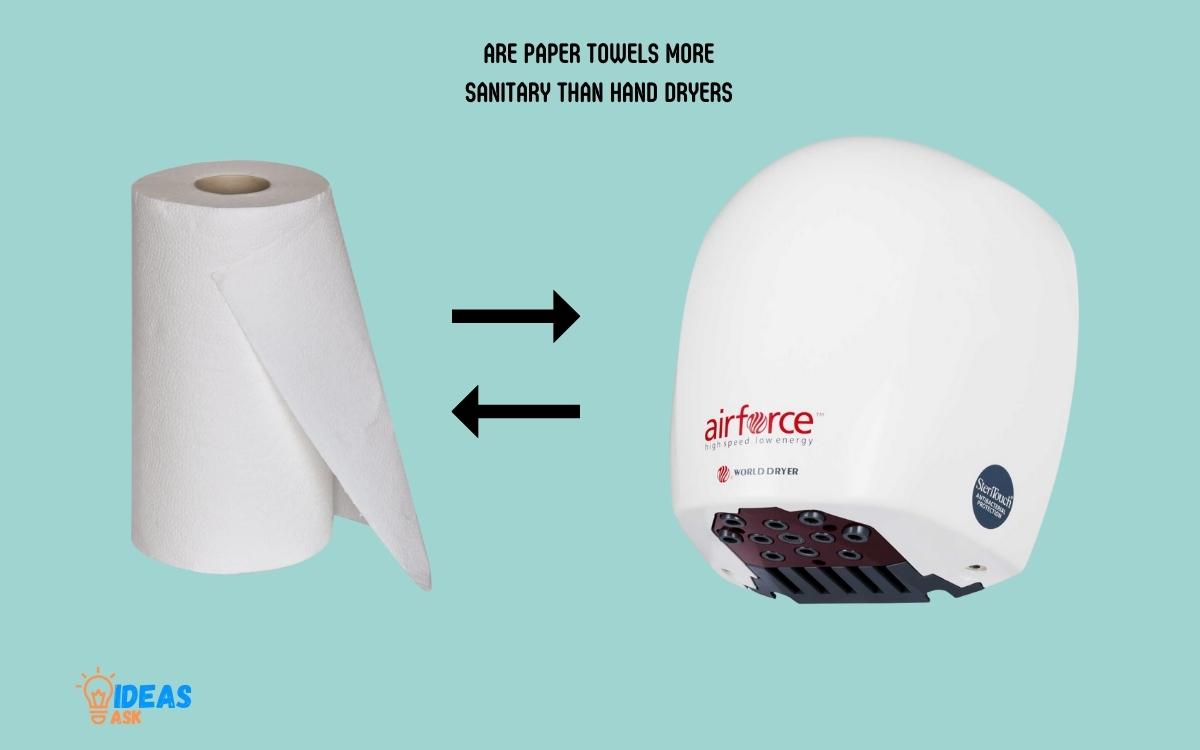Are Paper Towels More Sanitary Than Hand Dryers? Yes!
Yes, paper towels are often more sanitary than hand dryers. Studies show that paper towels can effectively remove bacteria from hands, while hot air dryers can actually increase the number of bacteria or spread them around the restroom.
When you wash your hands, not all bacteria and germs are removed. Some remain on your hands and can be spread to other surfaces. Paper towels not only dry your hands but can physically remove and contain these residual bacteria.
In contrast, hot air from hand dryers can spread bacteria around the room, potentially resulting in cross-contamination.
In terms of hygiene, paper towels show superiority over hand dryers. By providing physical friction, they can effectively remove residual bacteria from your hands.
Conversely, hand dryers, particularly hot air types, might spread these bacteria around the restroom, increasing the risk of potential cross-contamination. Thus, hygiene-wise, paper towels may be the better choice for drying hands.

Key Takeaway
The Science Behind Sanitation
Discover the science behind sanitation and explore the question: are paper towels more sanitary than hand dryers? Uncover the facts about hygiene and make an informed choice for cleaner hands.
Hand hygiene plays a crucial role in preventing the spread of germs and maintaining good health. Understanding the science behind sanitation can help us make informed decisions about the most effective hand hygiene methods and debunk common hygiene practice myths.
Understanding The Role Of Hand Hygiene In Preventing The Spread Of Germs:
- To prevent the transmission of harmful bacteria and viruses, proper hand hygiene is essential.
- Regularly washing our hands with soap and water helps to remove dirt, germs, and other microorganisms from our hands.
- The friction created during handwashing dislodges pathogens, reducing their ability to adhere to our skin.
- Hand sanitizers, containing at least 60% alcohol, can also effectively kill germs when soap and water are not readily available.
- Proper hand hygiene is especially important after using the restroom, before eating, and after coughing or sneezing.
The Efficacy Of Different Hand Hygiene Methods:
Paper towels:
- Studies have shown that disposable paper towels can effectively remove bacteria and viruses from hands.
- The act of drying hands with paper towels also contributes to the removal of pathogens.
- Paper towels are considered a safe and effective option in environments where hygiene is a priority.
Hand dryers:
- Hand dryers use warm air or high-speed jets of air to dry hands.
- While hand dryers can be convenient and reduce waste, their efficacy in removing germs is not as high as paper towels.
- Due to the forced air, hand dryers may spread bacteria and viruses to nearby surfaces, leading to cross-contamination.
Debunking Common Myths About Hygiene Practices:
- Hand dryers kill germs. Hand dryers do not eliminate germs but simply dry hands. Killing germs requires proper handwashing or the use of hand sanitizers.
- Hand dryers are more eco-friendly. While hand dryers can reduce paper towel waste, their manufacturing process and energy consumption can have a negative environmental impact.
- Paper towels are less hygienic due to frequent touch. Paper towels are designed for single-use, minimizing the chance of contact with contaminated surfaces. Additionally, they effectively remove microbes from hands.
- Hand sanitizers are as effective as handwashing. While hand sanitizers can effectively kill many germs, they may not remove all types of pathogens or substances from the hands, like dirt or chemicals.
By understanding the science behind sanitation and debunking common hygiene practice myths, we can make informed decisions about our hand hygiene routine.
Remember, proper handwashing with soap and water or using disposable paper towels is effective in reducing the spread of germs and maintaining good health.
Paper Towels: A Hygienic Choice
Effectiveness in Removing Germs:
Absorption Capacity and Thorough Drying:
Pros:
- Paper towels are known for their high absorption capacity, quickly drying hands and reducing the potential for bacterial growth in damp environments.
- The physical act of rubbing hands with paper towels can help remove a significant amount of germs and contaminants.
Cons:
- Some low-quality or thin paper towels may have lower absorption capacity, requiring users to use more sheets to achieve effective hand drying.
- Production processes of paper towels may involve chemicals that, in large quantities, can raise environmental concerns.
Minimizing Bacterial Transfer:
Pros:
- Paper towels are considered effective in minimizing bacterial transfer since they are single-use, reducing the risk of spreading germs from person to person.
- Proper handwashing followed by paper towel drying can be a hygienic combination, especially in public spaces.
Cons:
- If hands are not thoroughly washed before drying, any remaining bacteria can be transferred to the paper towel during the drying process.
Environmental Considerations:
Biodegradability and Sustainability:
Pros:
- Many paper towels are biodegradable, making them a more environmentally friendly option compared to non-biodegradable materials.
- Some brands offer recycled or sustainably sourced paper towels, further reducing their environmental impact.
Cons:
- The production of paper towels requires the cutting down of trees, contributing to deforestation if not sourced sustainably.
- The bleaching process in manufacturing can involve chemicals that may have environmental implications.
Resource Usage Comparison with Hand Dryers:
Pros:
- Paper towels have a lower upfront energy cost compared to electric hand dryers, which require electricity to operate.
- Paper towels are generally more accessible to people with disabilities who may struggle to use hand dryers.
Cons:
- The production and transportation of paper towels involve energy consumption and contribute to carbon emissions.
- Paper towels generate waste, and their disposal can contribute to landfill concerns if not properly managed.
The choice between paper towels and other hand drying methods involves weighing the effectiveness in germ removal against environmental considerations.
Striking a balance by opting for sustainably sourced, biodegradable paper towels and proper waste disposal practices can help minimize the environmental impact while maintaining hygienic standards.
Unveiling The Pros And Cons Of Hand Dryers
Hand dryers and paper towels both have their advantages and drawbacks in terms of sanitation. While hand dryers are more eco-friendly and cost-effective, paper towels are often considered more sanitary due to their ability to remove bacteria effectively.
Ultimately, the choice depends on individual preferences and priorities. Hand dryers have become a common sight in public restrooms, offering a convenient and efficient way to dry hands. However, there is a debate surrounding their hygiene levels compared to traditional paper towels.
How Hand Dryers Work And Their Impact On Hygiene:
- Hand dryers operate by blowing warm air onto wet hands, evaporating the water and leaving them dry.
- They are designed to reduce the risk of bacteria transfer, as there is no physical contact involved compared to paper towels.
- High-speed hand dryers have the added advantage of reducing bacterial contamination by minimizing the time your hands are exposed to the surrounding environment.
Energy Efficiency And Cost-Effectiveness Of Hand Dryers:
- Hand dryers are considered more environmentally friendly, as they reduce paper waste and the associated impact on forests.
- They require less maintenance than paper towel dispensers, as there is no need to constantly restock the supply.
- Although initial installation costs may be higher, hand dryers are often more cost-effective in the long run due to lower ongoing expenses.
Potential Drawbacks And Limitations Of Hand Dryer Usage:
- Hand dryers are known to produce noise, which can be bothersome to some individuals, especially those with sensory sensitivities.
- Some people find the sensation of hand dryers uncomfortable due to the air pressure and temperature.
- In high-traffic areas, the time it takes for all users to dry their hands using hand dryers can lead to congestion, causing delays in restroom use.
Hand dryers offer various benefits such as increased hygiene levels, energy efficiency, and cost-effectiveness. However, it is important to consider the potential drawbacks and limitations associated with their usage.
Ultimately, the decision between hand dryers and paper towels depends on individual preferences and the specific requirements of each restroom facility.
Comparing Hygiene Practices: Real-World Studies
Real-world studies analyze hygiene practices, exploring whether paper towels or hand dryers are more sanitary. Results shed light on the effectiveness of each method.
Analyzing Research Studies On The Effectiveness Of Paper Towels And Hand Dryers:
Research studies have been conducted to compare the hygiene practices of using paper towels versus hand dryers.
These studies evaluate factors such as bacteria count, hand contamination, and cross-contamination risks to determine which method is more sanitary.
Bacteria Count
Several studies have found that paper towels are more effective in reducing bacterial counts on hands compared to hand dryers.
This is due to the physical wiping action of paper towels, which helps remove bacteria from the skin’s surface. In contrast, hand dryers can potentially spread bacteria in the air and onto other surfaces.
Hand Contamination
Research has shown that hands dried with paper towels have lower levels of residual moisture compared to those dried with hand dryers.
Moisture on hands can promote bacterial growth and increase the risk of cross-contamination. Paper towels help remove moisture effectively, leaving hands drier and less prone to contamination.
Cross-Contamination Risks
Studies have indicated that using hand dryers can pose a higher risk of cross-contamination compared to paper towels.
Airborne particles generated by hand dryers can spread bacteria around the restroom environment, potentially leading to contamination of other surfaces and individuals. Paper towels, on the other hand, provide a more controlled and contained disposal method.
Findings and Conclusions
Based on these real-world studies, it can be concluded that paper towels have advantages over hand dryers when it comes to hygiene practices.
They are more effective in reducing bacterial counts, minimizing hand contamination, and mitigating cross-contamination risks.
While hand dryers can be convenient and environmentally friendly, paper towels offer a higher level of cleanliness and are particularly beneficial in high-traffic areas or locations where hand hygiene is crucial.
Remember, always prioritize proper handwashing techniques, regardless of the drying method used.
Factors To Consider
Factors such as hygiene and sanitation should be taken into consideration when deciding between paper towels and hand dryers.
Both options have their pros and cons, and it’s important to weigh these factors to make an informed choice for maintaining cleanliness in public spaces.
Hand hygiene is a critical aspect of maintaining personal cleanliness and preventing the spread of diseases.
In public restrooms, healthcare facilities, and food establishments, the choice between paper towels and hand dryers is an important consideration.
Making an informed choice requires evaluating the hygiene requirements in different settings, understanding user preferences and behavior, and following recommendations for optimal hand hygiene practices.
Hygiene Requirements In Different Settings
Public restrooms:
- High foot traffic: Public restrooms experience frequent usage, resulting in a higher demand for hand-drying solutions.
- Quick hand drying: Efficient hand drying is necessary to ensure convenience and minimize waiting times for the next user.
- Containment of waste: Proper management of disposable materials, such as paper towels, is crucial for maintaining cleanliness and preventing the spread of germs.
Healthcare facilities:
- Strict infection control measures: In healthcare settings, maintaining a sterile environment is paramount. Hand drying methods should effectively eliminate moisture and minimize the risk of bacterial contamination.
- Prevention of cross-contamination: Disposable paper towels can be hygienic, preventing the transfer of bacteria from one surface to another.
- Compliance with regulations: Healthcare facilities are subject to specific regulations and guidelines, which may influence the choice of hand drying options.
Food establishments:
- Food safety considerations: Hand hygiene is crucial in food establishments to prevent foodborne illnesses. Effective hand drying helps reduce the risk of transferring germs onto food items and preparation surfaces.
- Ease of use and efficiency: Restaurants and food establishments require hand drying solutions that are quick, easy to use, and minimize any potential disruption to service.
- Consideration of environmental impact: Sustainable practices may influence the choice between paper towels and hand dryers in food establishments.
User Preferences And Behavior: The Role Of Perceived Cleanliness
- Perceived cleanliness: Many individuals associate the use of paper towels with greater cleanliness due to the removal of moisture and the tactile sensation of a dry hand.
- Psychological satisfaction: Dry hands created by paper towels may lead to a perceived sense of greater hygiene, boosting overall satisfaction.
- User habits: Some individuals have ingrained habits or personal preferences when it comes to hand drying methods, which may influence their perception of cleanliness.
Recommendations For Optimal Hand Hygiene Practices
- Combination approach: Employing both paper towels and hand dryers can cater to different user preferences and provide comprehensive hand drying options.
- Adequate quantity and quality: Ensure an ample supply of paper towels or well-maintained hand dryers to meet the demand of users.
- Proper handwashing techniques: Encourage users to follow best practices for hand hygiene, including thorough handwashing with soap and water before drying.
- Regular maintenance: Regularly clean and maintain hand dryers or restock paper towel dispensers to ensure efficient operation and availability.
- User education: Provide clear signage or instructions to guide users in adopting appropriate hand hygiene practices.
By considering the hygiene requirements in different settings, understanding user preferences, and following recommendations for optimal hand hygiene practices, individuals and establishments can make informed choices between paper towels and hand dryers.
Ultimately, the goal is to promote effective hand hygiene and contribute to a clean and healthy environment.
Conclusion
Both paper towels and hand dryers have their own advantages and drawbacks in terms of sanitary effectiveness.
Paper towels offer the convenience of being single-use and efficient at removing moisture and potentially harmful bacteria from hands.
On the other hand, hand dryers are more eco-friendly, cost-effective, and reduce the risk of cross-contamination.
The decision on which option is more sanitary ultimately depends on the specific situation and needs. It is essential for businesses and individuals to carefully consider factors such as hygiene standards, environmental impact, and budget constraints when choosing between paper towels and hand dryers.
By understanding the advantages and drawbacks of each option, we can make informed choices that prioritize both cleanliness and sustainability.
So, whether you opt for paper towels or hand dryers, proper hand hygiene remains the key to keeping yourself and others safe from harmful germs.






